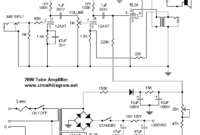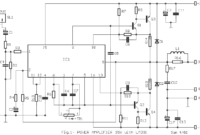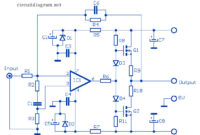This is the circuit diagram of stereo tube amplifier using 6SQ7-GT and 6V6-GT. The tube amplifier circuit is uses the total of 5 power vacuum tube. The diagram is based on the output section design of typical late 1940’s old AM Trutone radio with 6 tubes. The output will be 4 Watts per channel (2x4W stereo tube amplifier)
Parts list:
R1A & B = 500K? Dual gang Potentiometer
R2, R6 = 1M? 1/2W
R3, R7 = 470K? 1/2W
R4, R8 = 220K? 1/2W
R5, R9 = 330?, wire-wound or metal oxide 2W
R10 = 750?, wire-wound 20W
C1, C4 = 200pF/600v
C2, C5 = 47nF/600v
C3, C6 = 22uF/25v
C7 = 47uF/450V
C8 = 33nF/450V
C9 = 10nF/1400v
Power Transformer, T1
Primary = 117v 60 cycles
Sec. 1 = 600v CT @ 80mA
Sec. 2 = 5v @ 2A
Sec. 3 = 6.3v @ 4A
Audio Output Transformer T2, T3
Primary (impedance) = 3300 ? @ 400 cycles
Secondary (impedance) = 4 or 8 ? @ 400 cycles
Tubes:
6SQ7-GT
6V6-GT
5Y3-GT – Full-wave vacuum rectifier
Stereo tube amplifier notes:
- Do not forget hook-up wire, sockets, switch, and a chassis or circuit board. All tubes are octal type and will require an octal socket.
- For finest audio reproduction results, 90db/watt speakers or higher efficiency needs to be applied.
- Shield any hook-up wires used in the signal path between the input jack and the first audio tube.
- A choke coil having a DC resistance approximate to 750 ohms could be substituted for R10.
- R10 will generate considerable heat, and care needs to be taken in its location. I applied a large adjustable wire wound resistor for this and mounted it above the chassis. A choke coil in its place would give much better performance and extra closely resemble the electromagnet field within the prototype.
Stereo tube amplifier 4 Watts, design diagram source: wkinsler.com




